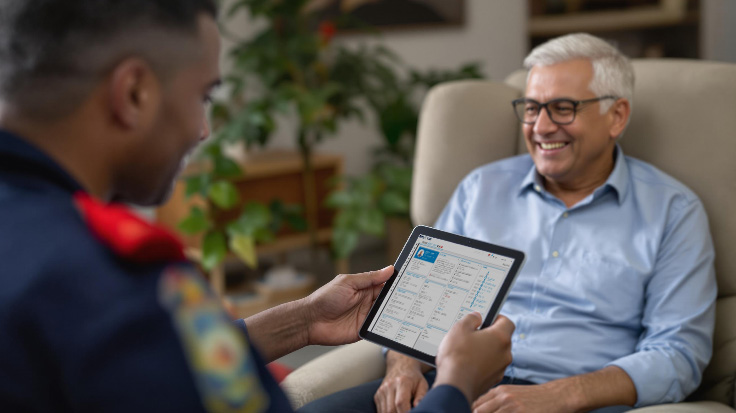The Secret Weapon Behind Every Successful MIH Program
Listen to this Article
Mobile Integrated Health (MIH) is an increasingly prevalent approach to bridging gaps in healthcare coverage – by proactively addressing the underlying needs of vulnerable populations, MIH programs both prevent burnout among EMS personnel and reduce costly ambulance runs and hospital visits. These programs can take on many different forms including fall prevention, substance abuse recovery, managing chronic conditions, and more. In light of current efforts to standardize an MIH dataset, this two-part series focuses on the backbone of all MIH programs: documentation.
In Part 1 we discussed how accurate, efficient record-keeping can help you on-scene: coordinating care teams, saving time, and ultimately improving patient care outcomes. In this article we’ll take a look behind the scenes: how documentation helps you secure funding, navigate new regulations, and guide your program’s growth.
In Part 1 we discussed how accurate, efficient record-keeping can help you on-scene: coordinating care teams, saving time, and ultimately improving patient care outcomes. In this article we’ll take a look behind the scenes: how documentation helps you secure funding, navigate new regulations, and guide your program’s growth.

Secure Funding by Proving Effectiveness
It’s the topic that comes up at every conference: how to secure funding for your program. Financial support can come from many places: federal and state programs, like Indiana’s EMS Commission; insurance companies, which save money by reducing health incidents; and hospitals, which save money by reducing ambulance transports. Which groups you partner with can depend on your community’s needs, grant availability, and even social connections – but no matter who it is, they’ll need proof of your program’s effectiveness.
The best way to prove your program’s effectiveness is to establish a clear measure of success. Common incidents to measure include 911 calls, hospital re-admissions, ambulance transports and ER visits. Many programs also measure specific incident types, like falls, heart attacks or opioid overdoses. Keep in mind that a simple total isn’t enough – you need to show how much that total has changed, compared to its historic values, and how much of that change is thanks to your program. To get started, you can often find the historic data you need by consulting with insurance companies, hospitals and EMS agencies.
Once you’ve found a funding partner and a measure of success, your documentation challenges begin. You’ll need to collect information about your operation, which can include time tracking, program graduations, health outcome improvements, and more. Your partner may also want contextual information, including aspects of patient demographics, medical history, non-medical needs, or anything else that helps them understand your population’s health needs. Spreadsheets can only go so far – you’ll need a solution that can keep track of the information you need, organize it for easy updating, and produce reports for your partners in whatever formats they require.
HealthCall specializes in tracking, organizing and reporting on data for MIH programs. Our patient-centric system tracks a wide variety of patient demographics and includes duplicate patient detection and resolution tools. Our SMART Chart assessments can be customized to record whatever data your program needs. Our interface allows for detailed searching and filtering, so you can find and update any record with ease, and our reporting suite securely exports whatever information your funding partners need.
Directing Program Growth
Once your program has proved its success, hopefully you’ll have the opportunity to expand, using the knowledge you’ve gained to address new conditions or hiring more manpower to serve new populations. The most useful documentation at this phase is a Community Needs Assessment. While these are vital for the first step on your MIH journey, they’re just as useful when it comes time to expand, as the healthcare gaps they reveal are a good indicator of where you can do the most good. You might also want to consult the same data you send to your funding partners: just as it gives them insights into your program’s success, so it can give you insights into scenarios your program struggles to handle. This insight can guide your program’s growth – you can expand into areas that avoid those scenarios, or hold off on expanding until you have the resources you need to properly handle them.
Keeping organized case records – and regularly reviewing them – can also help you spot when your program is spread too thin. Keep an eye out for trouble: cases that stall out due to too little manpower, too little availability or too few resources. If these turn from isolated incidents into a recurring problem, addressing that problem is vital for avoiding employee frustration and burnout – even if it means temporarily narrowing your focus. Staying informed can help you make these tough decisions with confidence, and ultimately lead your program to support even more of your community.
Staying Flexible in the Face of Regulations
It’s also wise to keep an eye on potential changes to the regulations you follow; as economic and political conditions shift, regulations often shift with them. This is especially relevant for funding partnerships, and not just those with federal and state organizations – after all, insurance companies and hospitals have their own regulations to abide. As such, whatever documentation solution you choose, it needs the flexibility to change and adapt.
A robust reporting engine is a good sign. A willingness to create custom reports is better; after all, no matter how many options your reporting service has, you’re bound to find a funding partner who wants something more. Even better than that is a willingness to add custom fields to your patient record – and seamlessly include them in your reports. With that level of flexibility, you can rest easy knowing that no matter what information your partners require, you’ll be able to provide it.
As for HealthCall, in addition to our flexible report generator, we have a long history of working with clients on custom reports and custom fields. We go to great lengths to incorporate client feedback into the design of our application, with new standard features added as we identify our clients’ recurring needs. After many years of experience, we’ve learned that the exceptions of today sometimes become the standards of tomorrow, and we’re always ready to adapt.
Documentation may never be your team’s favorite task of the day, but we hope this series has shown the positive impact it can have: providing valuable information on-scene, coordinating the different parties working with a patient, helping you maintain strong relationships with funding partners, and helping you manage your program’s growth over the years. HealthCall is happy to provide a flexible, customizable, user-friendly documentation solution, to support your amazing work as you serve communities in need.
